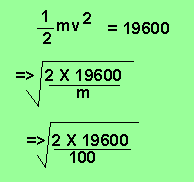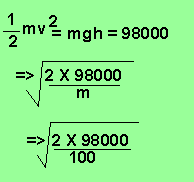Solution
The kinetic energy at "B" is 19,600 joules. The expression below
is true.

v = 19.8m/s
Click to hide the solution
Solution
The cart has only kinetic energy. It is at ground level so therefore no
gravitational potential energy exists.
The gravitational energy at the
start is equal to the kinetic energy present at "B"
kinetic energy("A")= gravitational potential(at the start) mgh
100 X 9.8 X 100 = 98,000 joules of kinetic energy
Click to hide solution
Solution
The cart has gravitational potential energy equal to
mgh = 100 X 9.8
X 80 = 78,400 joules
Now the cart started
with a gravitational potential energy of
mgh = 100 X 9.8 X 100 =98,000 joules.
The difference between the two potential energies (starting and the potential
at "B") is the kinetic energy the cart has at "B".
98,000 - 78,400 = 19,600 joules.
Click to hide the solution
Solution
The kinetic energy at "B" is 19,600 joules. The expression below
is true.

v = 19.8m/s
Click to hide the solution
Solution
The energy the cart has at "C" is all kinetic. The amount of kinetic energy is equal to the gravitational potential energy at the start.

v = 44.27m/s
Click to hide solution
|
Gravitational
into kinetic exercises 1
|
 |
|
1)
A 100Kg cart sits 100m above the ground. It rolls off the edge and drops
to ground level (point "A") along a roller coaster track. (Assume
no friction or air resistance and no energy loss from the system) Solution b)
What is the gravitational potential and kinetic energies of the cart at
"B"? Solution c)
What is the speed of the cart at "B" Solution d) What is the speed of the cart at "C" assuming that "C" is at ground level. Solution |